Development of Refrigerants and Compressors
Sakshi Education
Nagendra M<br/>
CBM Engineer, Hindusthan Zink .Ltd
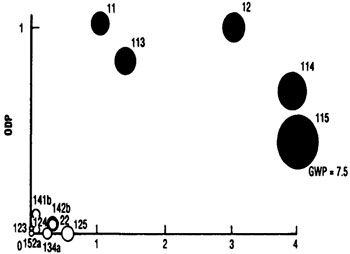

The objectives of the lesson are
- Refrigerant improvement
- Early refrigerants
- Manufactured fluorocarbon based refrigerants
- Non-ozone exhausting refrigerants
- Compressor improvement
- Low-speed steam motor driven compressors
- Rapid electric engine driven compressors
- Revolving vane and moving cylinder compressors
- Screw compressors
- Scroll compressors
- Radial compressors
2.1. Introduction:
The improvement of refrigeration and cooling industry depends on an expansive degree on the improvement of refrigerants to suit different applications and the advancement of different framework segments. At present the business is overwhelmed by the vapor pressure refrigeration frameworks, despite of the fact that the vapor ingestion frameworks have likewise been created industrially. The achievement of vapor pressure refrigeration frameworks owes a considerable measure to the advancement of suitable refrigerants and compressors. The hypothetical thermodynamic proficiency of a vapor pressure framework depends basically on the working temperatures. Not withstanding, imperative handy issues, for example, the framework outline, size, starting and working expenses, security, unwavering quality, and service ability and so forth depends all that much on the kind of refrigerant. Furthermore compressor are chosen for an given application.
This lesson introduces a short history of refrigerants and compressors. The accentuation here is for the most part on vapor compression refrigeration frameworks, as these are the most ordinarily utilized frameworks, furthermore refrigerants and compressors assume a basic part here. The other well known sort of refrigeration framework, specifically the vapor retention sort has seen less changes regarding refrigerant advancement, and moderately less number of issues exist in these frameworks to the extent that the refrigerants are Concerned.
2.2. Refrigerant development
By and large, a refrigerant may be characterized as "a substance that goes about as a cooling medium by separating high temperature from an alternate body or substance". Under this general definition, numerous bodies or substances may be called as refrigerants, e.g. ice, icy water, chilly air and so forth. In shut cycle vapor pressure, retention frameworks, air cycle refrigeration frameworks: the refrigerant is a working liquid that experiences cyclic changes. In a thermoelectric framework the current convey electrons may be dealt with as a refrigerant. On the other hand, ordinarily by refrigerants we mean the working liquids that experience buildup and vanishing as in pressure and retention frameworks.
The history that we are discussing basically alludes to these substances. Since these substances need to vanish and gather at obliged temperatures (which might comprehensively lie in the scope of –100oC to +100oC) at sensible weights, they must be basically unstable. Thus, the advancement of refrigerants began with the quest for suitable, unpredictable substances. Verifiably the improvement of these refrigerants can be partitioned into three different stages, to be specified:
i. Refrigerants prior to the development of CFCs
ii. The synthetic fluorocarbon (FC) based refrigerants
iii. Refrigerants in the aftermath of stratospheric ozone layer depletion
2.2.1. Refrigerants prior to the development of CFCs
Water is one of the most punctual substances to be utilized as a refrigerant, but not in a shut framework. The Creation of cool by vanishing water goes over to 3000 B.C. chorological discoveries shown in pictures of Egyptian slaves waving fans before ceramic jugs to quicken the dissipation of water from the permeable surfaces of the pots, subsequently creating chilly water. Obviously, the utilization of "punkahs" for body cooling in hot summer is exceptionally remarkable in nations like India. Generation of ice by nighttime cooling is additionally extraordinary.
Individuals likewise had some information of creating below zero temperatures by the utilization of "refrigerant mixtures". It is accepted as right over fourth Century AD that individuals in India were utilizing mixtures of salts (sodium nitrate, sodium chloride and so forth) and water to deliver temperatures as low as –20oC. These characteristics of refrigeration frameworks working with water have numerous confinements and thus were kept to a little number of utilization. Water was the first refrigerant to be utilized as a part of a nonstop refrigeration framework by William Cullen (1710-1790) in 1755. William Cullen is likewise the first man to have logically watched the generation of low temperatures by dissipation of ethyl ether in 1748.
Ethyl ether gave off an impression of being a decent refrigerant before all else, as it was less demanding to handle it since it exists as a fluid at conventional temperatures and air weight. Ethyl ether has a typical breaking point (NBP) of 34.5oC, this shows that with a specific end goal to acquire low temperatures the evaporator weight must be lower than one climate i.e., operation in vacuum. Operation of a framework in vacuum may prompt the risk of outside air spilling into the framework bringing about the development of a possibly touchy mixture. Then again a moderately high ordinary breaking point demonstrates lower weights in the condenser, or for a given weight the condenser can be worked at higher gathering temperatures. This is the reason behind the more drawn out utilization of ether in tropical nations with high encompassing temperatures.
Since it is non-combustible and non-dangerous it discovered wide applications basically for marine refrigeration. It was additionally utilized for refrigeration applications ashore. Carbon dioxide was utilized effectively for around sixty years anyway, it was totally supplanted by CFCs. It is humorous to note that the following time when the issue of ozone layer exhaustion was discovered, carbon dioxide is consistently making a rebound by supplanting the manufactured CFCs/HCFCs/HFCs and so on. One of the point of interesting occasions in the historical backdrop of refrigerants is the presentation of alkali. The American David Boyle (1837-1891) was allowed the first patent for alkali compressor in 1872. He made the first single acting vertical compressor in 1873.
Smelling salts has brilliant thermodynamic and thermo-physical properties. It is effectively accessible and economical. On the other hand, alkali is lethal and has a solid scent and slight combustibility. Moreover, it is not perfect with a percentage of the regular materials of development, for example, copper. Despite of the fact that these are thought to be some of its burdens, smelling salts has stood the test of time and the attack of CFC's because of its fantastic properties. At present smelling salts is utilized as a part of substantial refrigeration frameworks (both vapor pressure and vapor ingestion) furthermore in little assimilation coolers (triple liquid vapor retention).
2.2.2. The synthetic CFCs/HCFCs:
Pretty much all the refrigerants utilized as a part of the early phases of refrigeration experienced one issue or other. A large portion of these issues were connected to well being issues, for example, lethality, combustibility, high working weights and so on. Accordingly expansive scale commercialization of refrigeration frameworks was hampered. Henceforth it was felt that "refrigeration industry needs another refrigerant in the event that they hope to go any place". The undertaking of discovering a "safe" refrigerant was taken up by the American Thomas Midgley, Jr., in 1928. Midgley was at that point renowned for the creation of tetra ethyl lead, an imperative hostile to thump specialists for petrol motors.
Midgley alongside his partners Albert L. Henne and Robert R. McNary at the Frigidaire Laboratories (Dayton, Ohio, USA) started an efficient investigation of the occasional table. From the intermittent table they immediately disposed of each one of those substances yielding inadequate unpredictability. They then wiped out those components bringing about flimsy and harmful gasses and additionally the latent gasses, taking into account their low breaking points. They were at last left with eight components: carbon, nitrogen, oxygen, sulphur, hydrogen, fluorine, chlorine and bromine. These eight components grouped at a meeting column and section of the intermittent table, with fluorine at the convergence. Midgley and his partners then mentioned three fascinating observable facts:
i. Combustibility diminishes from left to a good fit for the eight components
ii. Toxicity for the most part declines from the substantial components at the base to the lighter components at the top
iii. Each known refrigerant around then was produced using the mix of those eight "Midgley" components.
Fig 4: Relative ODP and halocarbon GWP of several HCFCs, CFCs, and HFCs.
A glance at the refrigerants examined above demonstrates that every one of them are comprised of seven out of the eight components distinguished by Midgley (fluorine was not utilized till then). Other specialists have rehashed Midgley's pursuit with more advanced hunt systems and databases, anyway touched base at the same conclusions (pretty much all the presently utilized refrigerants are comprised of Midgley components, just exemption is Iodine, studies are being done on refrigerants containing iodine notwithstanding a percentage of the Midgley components). Taking into account their study, Midgely and his partners have built up an entire scope of new refrigerants, which are gotten by halfway substitution of hydrogen particles in hydrocarbons by fluorine and chlorine.
They have indicated how fluorination and chlorination of hydrocarbons can be differed to acquire coveted breaking points (instability), furthermore how properties, for example, harmfulness and combustibility, are impacted by the structure. The primary business refrigerant to leave Midgley's study is Freon-12 in 1931. Freon-12 with a synthetic equation CCl2F2, is got by supplanting the four particles of hydrogen in methane (CH4) by two molecules of chlorine and two iotas of fluorine. Freon-12 has a typical breaking point of 29.8oC, and is a standout among the most popular and prominent manufactured refrigerants. It was solely utilized as a part of little residential iceboxes, ventilation systems, water coolers and so on for just about sixty years. Freon-11 (CCl3F) utilized as a part of expansive divergent aerating and cooling frameworks was presented in 1932.
This is trailed by Freon-22 (CHClF2) and an entire arrangement of manufactured refrigerants to suit a wide mixture of utilization. Because of the development of a substantial number of refrigerants notwithstanding the presence of the more established refrigerants, it has ended up vital to work out a numbering framework for refrigerants. Along these lines all refrigerants were shown with "R" emulated by an one of a kind number (subsequently Freon-12 is changed to R12 and so forth). The numbering of refrigerants was carried out taking into account certain rules. For all engineered refrigerants the number (e.g. 11, 12, 22) signifies the substance organization. The quantity of all inorganic refrigerants starts with "7" emulated by their atomic weight. Hence R-717 indicates (alkali is inorganic and its atomic weight is 17), R-718 signifies water and so forth.. Refrigerant mixtures start with the number 4 (geotropic) or 5 (azeotropic), e.g. R-500, R-502 and so on.
2.2.3. Refrigerants in the aftermath of Ozone Layer Depletion:
The most critical prerequisite for refrigerants in the repercussions of ozone layer consumption is that it ought to be a non-Ozone Depleting Substance (non-ODS). Out of this prerequisite two options have risen. The first is to search for zero ODP manufactured refrigerants and the second one is to search for "characteristic" substances. Presentation of hydro fluorocarbons (HFCs) and their mixtures fit in with the first course, while the reintroduction of carbon dioxide (in a supercritical cycle), water and different hydrocarbons and their mixtures fit in with the second course.
The expanded utilization of alkali and utilization of other refrigeration cycles, for example, air cycle refrigeration frameworks and retention frameworks additionally go under the second course. Both these courses have discovered their defenders and adversaries. HFC- 134a (manufactured substance) and hydrocarbons (characteristic substances) have risen as choices to Freon-12. No reasonable immaculate liquid option has been found so far for the other well known refrigerant HCFC-22. However a few mixtures comprising of manufactured and characteristic refrigerants are being utilized and recommended for future utilization.
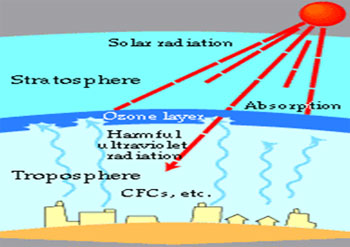
Refrigerants in the aftermath of Ozone Layer Depletion
Table 2.1 demonstrates the rundown of refrigerants being supplanted and their plan B. Notice must be made here about the other natural issue, an unnatural weather change. When all is said in done the non-ODS manufactured refrigerants, for example, HFC-134a have high an unnatural weather change potential (GWP), consequently they confront a questionable future. Since the a worldwide temperature alteration effect of a refrigerant additionally relies on upon the vitality effectiveness of the framework utilizing the refrigerant (circuitous impact), the productivity issue has gotten to be critical in the configuration of new refrigeration frameworks.
In spite of the fact that the issues of ozone layer exhaustion and a dangerous atmospheric deviation has prompted a few issues, they have additionally had advantageous impacts of making individuals understand the criticalness of natural agreeableness of advancements. It is normal that with the more prominent mindfulness more mindful plans will develop which will at last advantage the entire humankind.
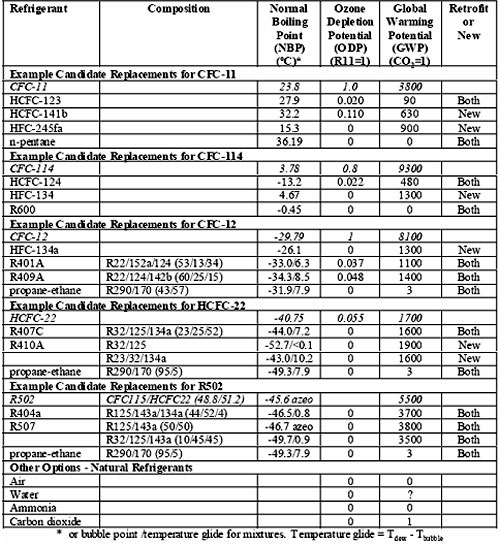
Table 2.1. Candidate refrigerants for replacing CFCs
2.3. Compressor development
Compressor may be called as a heart of any vapor compression system. The rapid development of refrigeration systems is made possible due to the developments in compressor technologies.
2.3.1. Reciprocating compressors:
The soonest compressor utilized by Jakob Perkins is a hand-worked compressor, all that much like a hand worked pump utilized for pumping water. Harrison likewise utilized a hand-worked ether compressor in 1850, however later utilized steam motor driven compressors as a part of business machines. A little half drive (hp) compressor was utilized as ahead of schedule as 1857 to create 8kg of ice every hour. Three different machines with 8 to 10 hp were being used in England in 1858. In 1859, the firm P.N. Russel of Australia embraced the assembling of Harrison's machines, the principal compressors to be made with two vertical barrels. The firm of Siebe siblings of England continued idealizing the outline of the early compressors. Their first compressors were vertical and the later were flat. From 1863 to 1870, Ferdinand Carre of France took out a few licenses on stomach compressors, valves and so forth.
They began producing two-stage carbon dioxide compressors since 1889. Before long the carbon dioxide frameworks supplanted air cycle refrigeration frameworks in boats. A few firms began fabricating these compressors on an expansive scale. This pattern proceeded up to the Second World War. A critical improvement occurred in 1876 by the presentation of a twin barrel vertical compressor working with smelling salts via Carl von Linde. Like his prior methyl ether compressor (1875) a shower of fluid mercury was utilized to make the compressor gas-tight. This smelling salts compressor was introduced in a bottling works in 1877 and worked there till 1908. In 1877, Linde enhanced the compressor outline by presenting an even, twofold acting chamber with a stuffing box produced using two packing's differentiated by (glycerin was later supplanted by mineral oil). Figure 2.1 demonstrates the schematic of Linde's flat, twofold acting compressor.
This configuration got to be exceptionally fruitful, and was a subject of numerous licenses. A few producers in different nations received this configuration and fabricated a few of these compressors. USA started the generation of alkali compressors on a huge scale from 1880. Raoul Pictet created the sulfur dioxide compressor in 1874. The machine was at first inherent Geneva, then in Paris and a short time later in some different nations. The compressor grew by Pictet was even and was not greased up as sulfur dioxide goes about as an auto-grease. As specified some time recently, the sulfur dioxide framework was a moment achievement and was utilized for very nearly sixty years, particularly in little frameworks.
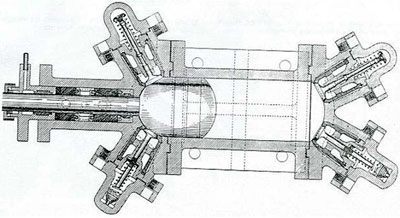
Fig.2.1. Schematic of Linde’s horizontal, double acting compressor
Stetefeld in 1904 presumed that there was no stamped distinction in the execution of alkali, carbon dioxide and sulfur dioxide compressors. Because of numerous similitudes, the early compressors looked like steam motors from multiple points of view. Like right on time steam motors, they were twofold acting (pressure happens on both sides of the cylinder). Both vertical and flat plans were utilized, the previous being mainstream in Europe while the later was prevalent in USA. A stuffing box game plan with oil in the hole was utilized to decrease refrigerant spillage.
The crosshead, uniting pole, wrench and flywheel were in the open. At first poppet valves were utilized, which were later changed to ring-plate sort. The chamber breadths were vast by the present day gauges, regularly around 500 mm with stroke lengths of the request of 1200 mm. The rotational rates were low (~ 50 rpm), consequently the clearances were little, regularly under 0.5 % of the cleared volume. Because of liberal valve ranges and low speed the early compressors had the capacity pack mixture of vapor and also fluid. Gradually, the pace of compressors have been expanded, for instance for a 300 kW cooling limit framework, the mean velocity was 40 rpm in 1890, 60 in 1900, 80 in 1910, 150 to 160 in 1915, and went upto 220 in 1916. The expression "fast" was presented in 1915 for compressors with paces more noteworthy than 150 rpm.
Then again, for littler compressors the vitality misfortune because of grinding at the stuffing box was calm high. This offered climb to the thought of fixed or hermetic compressor (both compressor and engine are mounted in the same nook). Then again, subsequent to the early electric engines with brushes and commutator and primitive protection deferred the acknowledgment of hermetic compressors up to the end of First World War. As specified, the most punctual compressors were hand worked. Later they were determined by steam motors. Then again, the steam motors progressively offered approach to electric engines.
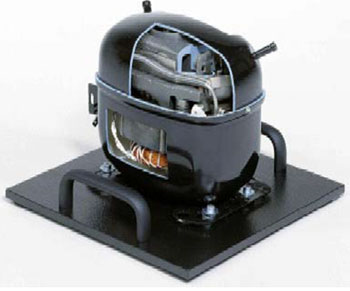
Fig.2.2. Cut view of a hermetic compressor
In the open sort Compressors the compressor and engine are mounted independently. The driving shaft of the engine and the crankshaft of the compressor are joined either by a cinch drive or an apparatus drive. With the open sort compressors there is dependably a plausibility of refrigerant spillage from an open sort compressor, despite the fact that the pivoting mechanical seals created lessened the spillage rate extensively. Since spillage can't be killed totally, frameworks working with open sort compressors oblige occasional adjusting and upkeep. Since it is hard to give nonstop upkeep on little frameworks (e.g. residential iceboxes), genuine thought was given to handle this issue. A hermetic or fixed compressor was the result of this.
An Australian Douglas Henry Stokes made the initially fixed or hermetic compressor in 1918. Hermetic compressors soon got to be amazingly prominent, and the fast improvement of little hermetic compressors has made ready for taking the refrigeration frameworks to the family units. With the capacitor beginning of the electric engine getting to be basic in 1930s, the configuration of hermetic compressors was idealized. In 1926, General Electric Co. of USA presented the local fridge working with a hermetic compressor. At first 4-shaft engines were utilized. After 1940 the 4-shaft engines were supplanted by 2-post engines, which diminished of the compressor unit essentially. Before long the 2-post hermetic refrigerant compressor got to be widespread.
Slowly, the limit of hermetic compressors was expanded. Presently a - days hermetic compressors are accessible for refrigerating limits beginning from a couple of Watts to kilowatts. At present, because of higher proficiency and serviceability, the open sort compressors are utilized as a part of medium to expansive limit frameworks, while the hermetic compressors are only utilized as a part of little limit frameworks on a large scale manufacturing. The right now accessible hermetic compressors are reduced and greatly dependable. They are accessible for a wide mixed bag of refrigerants and applications. Figure 2.2 shows cut perspective of a hermetic compressor.
Other types of compressors:
2.3.2.Positive displacement type (other than reciprocating):
In 1919, the French engineer Henri Corblin (1867-1947) patented a diaphragm compressor, in which the alternating movement of a diaphragm produced the suction and compression effects. Initially these compressors were used for liquefying chlorine, but later were used in small to medium capacity systems working with ammonia, carbon dioxide etc. Several types of rotary air compressors existed before the First World War, and this idea has soon been extended to refrigerants.
However, they became popular with the introduction of Freon’s in 1930s. The first positive displacement, rotary vane compressor using methyl chloride was installed on an American ship “Carnegie”. However, a practical positive displacement, rotary vane compressor could only be developed in 1920. In Germany, F.Stamp made an ethyl chloride compressor of 1000 kcal/h capacity. In USA, Sunbeam Electric made small sulphur dioxide based rotary sliding vane compressors of 150 kcal/h capacity, rotating at 1750 rpm for domestic refrigerators. In 1922, Sulzer, Switzerland made “Frigorotor” of 1000 to 10000 kcal/h using methyl chloride. Sulzer later extended this design to ammonia for large capacities (“Frigocentrale”). Escher Wyss, also of Switzerland rotary sliding vane compressor “Rotasco” in 1936. These compressors were also made by Lebrun, Belgium in 1924 and also by Grasso (Netherlands).
At present, positive displacement rotary compressors based on sliding vane and rolling piston types are used in small to medium capacity applications all over the world. These compressors offer the advantages of compactness, efficiency, low noise etc. However, these compressors require very close manufacturing tolerances as compared to reciprocating compressors. Figure 2.3 shows the schematic of a rolling piston compressor. The low pressure refrigerant from the evaporator enters into the compressor from the port on the right hand side, it gets compressed due to the rotation of the rolling piston and leaves the compressor from the discharge valve on the left hand side.
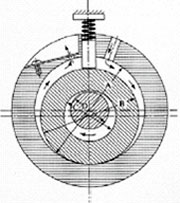
Fig.2.3. Schematic of a rolling piston type, rotary compressor
The screw compressors went into refrigeration advertise in 1958, despite the fact that the essential thought back pedals to 1934, by A. Lysholm of Sweden. The screw compressors are of twin-screw (two helical rotors) sort or a solitary screw (single rotor) sort. The twin-screw compressor utilizes a couple of inter meshing rotors rather than a cylinder to create pressure. The rotors involve helical flaps settled to a pole. One rotor is known as the male rotor and it will ordinarily have four bulbous projections.
The other rotor is the female rotor and this has valleys machined into it that match the bend of the male projections. Regularly the female rotor will have six valleys. This implies that for one upset of the male rotor, the female rotor will just turn through 240 deg. For the female rotor to finish one cycle, the male rotor will need to turn 11/2 times. The single screw sort compressor was first made for air in 1967. Grasso, Netherlands presented single sink refrigerant compressors 1974. The screw compressor (both single and twin screw) got to be prominent subsequent to 1960 and its plan has practically been idealized.
In a matter of seconds it is made for medium to vast limit range for alkali and fluorocarbon based refrigerants. It contends with the responding compressors at the lower limit range and on the higher limit side it rivals the radial compressor. Because of the numerous ideal execution qualities, screw compressors are taking bigger and bigger offer of refrigerant compressor market. Figure 2.4 demonstrates the photo of a cut, semi-hermetic, single-screw compressor.
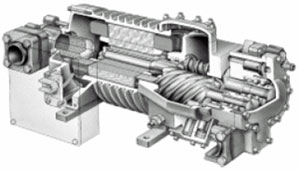
Fig.2.4. Cut view of a semi-hermetic, single-screw compressor
The parchment compressor is one of the later however vital sorts of positive removal compressors. It utilizes the pressure activity gave by two inter-meshing parchments - one altered and the other circling. This orbital development draws gas into the pressure chamber and moves it through progressively littler "pockets" framed by the scroll's revolution, until it achieves most extreme weight at the middle of the chamber. There, its discharged through a release port in the settled parchment.
Amid each one circle, a few pockets are packed all the while, so operation is for all intents and purposes nonstop. Figure 2.5 shows gas stream design in a parchment compressor and Fig.2.6 demonstrates the photo of a Copeland scroll compressor. The guideline of the parchment compressor was created amid the early 1900's and was protected without precedent for 1905. In spite of the fact that the hypothesis for the parchment compressor showed a machine conceivably equipped for sensibly great efficiency, around then the innovation essentially didn't exist to precisely fabricate the parchments. It was very nearly after 65 years that the idea was re-developed by a refrigeration industry quick to adventure the possibilities of parchment innovation.
Copeland in USA, Hitachi in Japan presented the parchment kind of compressors for refrigerants in 1980s. Scroll compressors have been created for working temperatures in the scope of 45°C to +5°C suitable for cool stockpiling and aerating and cooling applications. This parchment has likewise been effectively connected all through the world in numerous cooler applications. Today, scroll compressors are extremely famous because of the high proficiency, which comes about because of higher pressure attained to at a lower rate of spillage. They are accessible in cooling limits up to 50 kW. They are tranquil in operation and reduced. Be that as it may, the assembling of parchment compressors is exceptionally confused because of the greatly close resistances to be kept up for fitting operation of the compressor.
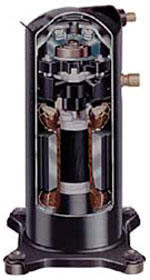
Fig.2.6. Photograph of a cut scroll compressor (Copeland)
2.3.3. Dynamic type:
Radiating compressors (otherwise called turbo compressors) fit in with the class of element kind of compressors, in which the weight climb happens because of the trading of precise energy between the pivoting edges and the vapour caught in the middle of the sharpened pieces of steels. Divergent were at first utilized for packing air. The advancement of these compressors is generally because of the endeavors of Auguste Rateau of France from 1890. In 1899, Rateau created single impeller (rotor) and later multi-impeller fans. Endeavors have been made to utilize comparable compressors for refrigeration. In 1910, two Germans H. Lorenz and E. Elgenfeld proposed the utilization of divergent compressors for refrigeration at the International Congress of Refrigeration, Vienna. Be that as it may, it was Willis H. Transporter, who has truly established the framework of radial compressors for aerating and cooling applications in 1911.
The inspiration for creating diffusive compressors started from the way that the responding compressors were moderate and cumbersome, particularly for substantial limit frameworks. Bearer needed to add to a more reduced framework working with non-combustible, non-poisonous and unscented refrigerant. In 1919, he attempted a radiating compressor with dichloroethylene (C2H2Cl2) and afterward dichloromethane (CCl2H2). In 1926 he utilized methyl chloride, and in 1927 he had about 50 compressors working with dichloroethylene. The diffusive compressors truly took-off with the presentation of Freons in 1930s. Refrigerant R11 was the refrigerant picked via Carrier for his divergent compressor based ventilating frameworks in 1933. Later his organization created outward compressors working with R12, propane and other refrigerants for utilization in low temperature applications.
In Switzerland, Brown Bovary Co. Created smelling salts based diffusive compressors as ahead of schedule as 1926. Later they additionally grew substantial radial compressors working with Freon's. Till 1950, the divergent compressors were utilized basically as a part of USA for cooling applications. Nonetheless, in this way diffusive compressors have gotten to be industry standard for huge refrigeration and cooling applications everywhere throughout the world. Divergent compressors grew before 1940, had 5 to 6 stages, while they had 2 to 3 stages between 1940 to 1960. After 1960, divergent compressors with a solitary stage were additionally created. Accordingly, smaller, hermetic outward compressor produced for medium to substantial limit applications. The vast distance across, 3600 rpm machines were supplanted by minimal 10000 to 12000 rpm compressors.
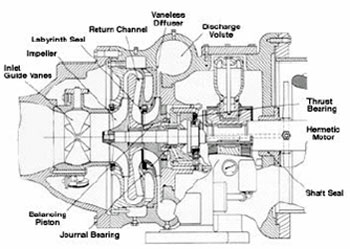
Fig. 2.7 Cut-view of a two-stage, semi-hermetic centrifugal compressor
Substantial radiating compressors of cooling limits in the scope of 200000 kcal/h to 2500000 kcal/h were utilized as a part of spots, for example, World Trade Centre, New York. Figure 2.7 shows cut-perspective of a two-stage, semi-hermetic divergent compressor.
The improvement of refrigeration and cooling industry depends on an expansive degree on the improvement of refrigerants to suit different applications and the advancement of different framework segments. At present the business is overwhelmed by the vapor pressure refrigeration frameworks, despite of the fact that the vapor ingestion frameworks have likewise been created industrially. The achievement of vapor pressure refrigeration frameworks owes a considerable measure to the advancement of suitable refrigerants and compressors. The hypothetical thermodynamic proficiency of a vapor pressure framework depends basically on the working temperatures. Not withstanding, imperative handy issues, for example, the framework outline, size, starting and working expenses, security, unwavering quality, and service ability and so forth depends all that much on the kind of refrigerant. Furthermore compressor are chosen for an given application.
This lesson introduces a short history of refrigerants and compressors. The accentuation here is for the most part on vapor compression refrigeration frameworks, as these are the most ordinarily utilized frameworks, furthermore refrigerants and compressors assume a basic part here. The other well known sort of refrigeration framework, specifically the vapor retention sort has seen less changes regarding refrigerant advancement, and moderately less number of issues exist in these frameworks to the extent that the refrigerants are Concerned.
2.2. Refrigerant development
By and large, a refrigerant may be characterized as "a substance that goes about as a cooling medium by separating high temperature from an alternate body or substance". Under this general definition, numerous bodies or substances may be called as refrigerants, e.g. ice, icy water, chilly air and so forth. In shut cycle vapor pressure, retention frameworks, air cycle refrigeration frameworks: the refrigerant is a working liquid that experiences cyclic changes. In a thermoelectric framework the current convey electrons may be dealt with as a refrigerant. On the other hand, ordinarily by refrigerants we mean the working liquids that experience buildup and vanishing as in pressure and retention frameworks.
The history that we are discussing basically alludes to these substances. Since these substances need to vanish and gather at obliged temperatures (which might comprehensively lie in the scope of –100oC to +100oC) at sensible weights, they must be basically unstable. Thus, the advancement of refrigerants began with the quest for suitable, unpredictable substances. Verifiably the improvement of these refrigerants can be partitioned into three different stages, to be specified:
i. Refrigerants prior to the development of CFCs
ii. The synthetic fluorocarbon (FC) based refrigerants
iii. Refrigerants in the aftermath of stratospheric ozone layer depletion
2.2.1. Refrigerants prior to the development of CFCs
Water is one of the most punctual substances to be utilized as a refrigerant, but not in a shut framework. The Creation of cool by vanishing water goes over to 3000 B.C. chorological discoveries shown in pictures of Egyptian slaves waving fans before ceramic jugs to quicken the dissipation of water from the permeable surfaces of the pots, subsequently creating chilly water. Obviously, the utilization of "punkahs" for body cooling in hot summer is exceptionally remarkable in nations like India. Generation of ice by nighttime cooling is additionally extraordinary.
Individuals likewise had some information of creating below zero temperatures by the utilization of "refrigerant mixtures". It is accepted as right over fourth Century AD that individuals in India were utilizing mixtures of salts (sodium nitrate, sodium chloride and so forth) and water to deliver temperatures as low as –20oC. These characteristics of refrigeration frameworks working with water have numerous confinements and thus were kept to a little number of utilization. Water was the first refrigerant to be utilized as a part of a nonstop refrigeration framework by William Cullen (1710-1790) in 1755. William Cullen is likewise the first man to have logically watched the generation of low temperatures by dissipation of ethyl ether in 1748.
Ethyl ether gave off an impression of being a decent refrigerant before all else, as it was less demanding to handle it since it exists as a fluid at conventional temperatures and air weight. Ethyl ether has a typical breaking point (NBP) of 34.5oC, this shows that with a specific end goal to acquire low temperatures the evaporator weight must be lower than one climate i.e., operation in vacuum. Operation of a framework in vacuum may prompt the risk of outside air spilling into the framework bringing about the development of a possibly touchy mixture. Then again a moderately high ordinary breaking point demonstrates lower weights in the condenser, or for a given weight the condenser can be worked at higher gathering temperatures. This is the reason behind the more drawn out utilization of ether in tropical nations with high encompassing temperatures.
Since it is non-combustible and non-dangerous it discovered wide applications basically for marine refrigeration. It was additionally utilized for refrigeration applications ashore. Carbon dioxide was utilized effectively for around sixty years anyway, it was totally supplanted by CFCs. It is humorous to note that the following time when the issue of ozone layer exhaustion was discovered, carbon dioxide is consistently making a rebound by supplanting the manufactured CFCs/HCFCs/HFCs and so on. One of the point of interesting occasions in the historical backdrop of refrigerants is the presentation of alkali. The American David Boyle (1837-1891) was allowed the first patent for alkali compressor in 1872. He made the first single acting vertical compressor in 1873.
Smelling salts has brilliant thermodynamic and thermo-physical properties. It is effectively accessible and economical. On the other hand, alkali is lethal and has a solid scent and slight combustibility. Moreover, it is not perfect with a percentage of the regular materials of development, for example, copper. Despite of the fact that these are thought to be some of its burdens, smelling salts has stood the test of time and the attack of CFC's because of its fantastic properties. At present smelling salts is utilized as a part of substantial refrigeration frameworks (both vapor pressure and vapor ingestion) furthermore in little assimilation coolers (triple liquid vapor retention).
2.2.2. The synthetic CFCs/HCFCs:
Pretty much all the refrigerants utilized as a part of the early phases of refrigeration experienced one issue or other. A large portion of these issues were connected to well being issues, for example, lethality, combustibility, high working weights and so on. Accordingly expansive scale commercialization of refrigeration frameworks was hampered. Henceforth it was felt that "refrigeration industry needs another refrigerant in the event that they hope to go any place". The undertaking of discovering a "safe" refrigerant was taken up by the American Thomas Midgley, Jr., in 1928. Midgley was at that point renowned for the creation of tetra ethyl lead, an imperative hostile to thump specialists for petrol motors.
Midgley alongside his partners Albert L. Henne and Robert R. McNary at the Frigidaire Laboratories (Dayton, Ohio, USA) started an efficient investigation of the occasional table. From the intermittent table they immediately disposed of each one of those substances yielding inadequate unpredictability. They then wiped out those components bringing about flimsy and harmful gasses and additionally the latent gasses, taking into account their low breaking points. They were at last left with eight components: carbon, nitrogen, oxygen, sulphur, hydrogen, fluorine, chlorine and bromine. These eight components grouped at a meeting column and section of the intermittent table, with fluorine at the convergence. Midgley and his partners then mentioned three fascinating observable facts:
i. Combustibility diminishes from left to a good fit for the eight components
ii. Toxicity for the most part declines from the substantial components at the base to the lighter components at the top
iii. Each known refrigerant around then was produced using the mix of those eight "Midgley" components.
Fig 4: Relative ODP and halocarbon GWP of several HCFCs, CFCs, and HFCs.
A glance at the refrigerants examined above demonstrates that every one of them are comprised of seven out of the eight components distinguished by Midgley (fluorine was not utilized till then). Other specialists have rehashed Midgley's pursuit with more advanced hunt systems and databases, anyway touched base at the same conclusions (pretty much all the presently utilized refrigerants are comprised of Midgley components, just exemption is Iodine, studies are being done on refrigerants containing iodine notwithstanding a percentage of the Midgley components). Taking into account their study, Midgely and his partners have built up an entire scope of new refrigerants, which are gotten by halfway substitution of hydrogen particles in hydrocarbons by fluorine and chlorine.
They have indicated how fluorination and chlorination of hydrocarbons can be differed to acquire coveted breaking points (instability), furthermore how properties, for example, harmfulness and combustibility, are impacted by the structure. The primary business refrigerant to leave Midgley's study is Freon-12 in 1931. Freon-12 with a synthetic equation CCl2F2, is got by supplanting the four particles of hydrogen in methane (CH4) by two molecules of chlorine and two iotas of fluorine. Freon-12 has a typical breaking point of 29.8oC, and is a standout among the most popular and prominent manufactured refrigerants. It was solely utilized as a part of little residential iceboxes, ventilation systems, water coolers and so on for just about sixty years. Freon-11 (CCl3F) utilized as a part of expansive divergent aerating and cooling frameworks was presented in 1932.
This is trailed by Freon-22 (CHClF2) and an entire arrangement of manufactured refrigerants to suit a wide mixture of utilization. Because of the development of a substantial number of refrigerants notwithstanding the presence of the more established refrigerants, it has ended up vital to work out a numbering framework for refrigerants. Along these lines all refrigerants were shown with "R" emulated by an one of a kind number (subsequently Freon-12 is changed to R12 and so forth). The numbering of refrigerants was carried out taking into account certain rules. For all engineered refrigerants the number (e.g. 11, 12, 22) signifies the substance organization. The quantity of all inorganic refrigerants starts with "7" emulated by their atomic weight. Hence R-717 indicates (alkali is inorganic and its atomic weight is 17), R-718 signifies water and so forth.. Refrigerant mixtures start with the number 4 (geotropic) or 5 (azeotropic), e.g. R-500, R-502 and so on.
2.2.3. Refrigerants in the aftermath of Ozone Layer Depletion:
The most critical prerequisite for refrigerants in the repercussions of ozone layer consumption is that it ought to be a non-Ozone Depleting Substance (non-ODS). Out of this prerequisite two options have risen. The first is to search for zero ODP manufactured refrigerants and the second one is to search for "characteristic" substances. Presentation of hydro fluorocarbons (HFCs) and their mixtures fit in with the first course, while the reintroduction of carbon dioxide (in a supercritical cycle), water and different hydrocarbons and their mixtures fit in with the second course.
The expanded utilization of alkali and utilization of other refrigeration cycles, for example, air cycle refrigeration frameworks and retention frameworks additionally go under the second course. Both these courses have discovered their defenders and adversaries. HFC- 134a (manufactured substance) and hydrocarbons (characteristic substances) have risen as choices to Freon-12. No reasonable immaculate liquid option has been found so far for the other well known refrigerant HCFC-22. However a few mixtures comprising of manufactured and characteristic refrigerants are being utilized and recommended for future utilization.

Refrigerants in the aftermath of Ozone Layer Depletion
Table 2.1 demonstrates the rundown of refrigerants being supplanted and their plan B. Notice must be made here about the other natural issue, an unnatural weather change. When all is said in done the non-ODS manufactured refrigerants, for example, HFC-134a have high an unnatural weather change potential (GWP), consequently they confront a questionable future. Since the a worldwide temperature alteration effect of a refrigerant additionally relies on upon the vitality effectiveness of the framework utilizing the refrigerant (circuitous impact), the productivity issue has gotten to be critical in the configuration of new refrigeration frameworks.
In spite of the fact that the issues of ozone layer exhaustion and a dangerous atmospheric deviation has prompted a few issues, they have additionally had advantageous impacts of making individuals understand the criticalness of natural agreeableness of advancements. It is normal that with the more prominent mindfulness more mindful plans will develop which will at last advantage the entire humankind.

Table 2.1. Candidate refrigerants for replacing CFCs
2.3. Compressor development
Compressor may be called as a heart of any vapor compression system. The rapid development of refrigeration systems is made possible due to the developments in compressor technologies.
2.3.1. Reciprocating compressors:
The soonest compressor utilized by Jakob Perkins is a hand-worked compressor, all that much like a hand worked pump utilized for pumping water. Harrison likewise utilized a hand-worked ether compressor in 1850, however later utilized steam motor driven compressors as a part of business machines. A little half drive (hp) compressor was utilized as ahead of schedule as 1857 to create 8kg of ice every hour. Three different machines with 8 to 10 hp were being used in England in 1858. In 1859, the firm P.N. Russel of Australia embraced the assembling of Harrison's machines, the principal compressors to be made with two vertical barrels. The firm of Siebe siblings of England continued idealizing the outline of the early compressors. Their first compressors were vertical and the later were flat. From 1863 to 1870, Ferdinand Carre of France took out a few licenses on stomach compressors, valves and so forth.
They began producing two-stage carbon dioxide compressors since 1889. Before long the carbon dioxide frameworks supplanted air cycle refrigeration frameworks in boats. A few firms began fabricating these compressors on an expansive scale. This pattern proceeded up to the Second World War. A critical improvement occurred in 1876 by the presentation of a twin barrel vertical compressor working with smelling salts via Carl von Linde. Like his prior methyl ether compressor (1875) a shower of fluid mercury was utilized to make the compressor gas-tight. This smelling salts compressor was introduced in a bottling works in 1877 and worked there till 1908. In 1877, Linde enhanced the compressor outline by presenting an even, twofold acting chamber with a stuffing box produced using two packing's differentiated by (glycerin was later supplanted by mineral oil). Figure 2.1 demonstrates the schematic of Linde's flat, twofold acting compressor.
This configuration got to be exceptionally fruitful, and was a subject of numerous licenses. A few producers in different nations received this configuration and fabricated a few of these compressors. USA started the generation of alkali compressors on a huge scale from 1880. Raoul Pictet created the sulfur dioxide compressor in 1874. The machine was at first inherent Geneva, then in Paris and a short time later in some different nations. The compressor grew by Pictet was even and was not greased up as sulfur dioxide goes about as an auto-grease. As specified some time recently, the sulfur dioxide framework was a moment achievement and was utilized for very nearly sixty years, particularly in little frameworks.

Fig.2.1. Schematic of Linde’s horizontal, double acting compressor
Stetefeld in 1904 presumed that there was no stamped distinction in the execution of alkali, carbon dioxide and sulfur dioxide compressors. Because of numerous similitudes, the early compressors looked like steam motors from multiple points of view. Like right on time steam motors, they were twofold acting (pressure happens on both sides of the cylinder). Both vertical and flat plans were utilized, the previous being mainstream in Europe while the later was prevalent in USA. A stuffing box game plan with oil in the hole was utilized to decrease refrigerant spillage.
The crosshead, uniting pole, wrench and flywheel were in the open. At first poppet valves were utilized, which were later changed to ring-plate sort. The chamber breadths were vast by the present day gauges, regularly around 500 mm with stroke lengths of the request of 1200 mm. The rotational rates were low (~ 50 rpm), consequently the clearances were little, regularly under 0.5 % of the cleared volume. Because of liberal valve ranges and low speed the early compressors had the capacity pack mixture of vapor and also fluid. Gradually, the pace of compressors have been expanded, for instance for a 300 kW cooling limit framework, the mean velocity was 40 rpm in 1890, 60 in 1900, 80 in 1910, 150 to 160 in 1915, and went upto 220 in 1916. The expression "fast" was presented in 1915 for compressors with paces more noteworthy than 150 rpm.
Then again, for littler compressors the vitality misfortune because of grinding at the stuffing box was calm high. This offered climb to the thought of fixed or hermetic compressor (both compressor and engine are mounted in the same nook). Then again, subsequent to the early electric engines with brushes and commutator and primitive protection deferred the acknowledgment of hermetic compressors up to the end of First World War. As specified, the most punctual compressors were hand worked. Later they were determined by steam motors. Then again, the steam motors progressively offered approach to electric engines.

Fig.2.2. Cut view of a hermetic compressor
In the open sort Compressors the compressor and engine are mounted independently. The driving shaft of the engine and the crankshaft of the compressor are joined either by a cinch drive or an apparatus drive. With the open sort compressors there is dependably a plausibility of refrigerant spillage from an open sort compressor, despite the fact that the pivoting mechanical seals created lessened the spillage rate extensively. Since spillage can't be killed totally, frameworks working with open sort compressors oblige occasional adjusting and upkeep. Since it is hard to give nonstop upkeep on little frameworks (e.g. residential iceboxes), genuine thought was given to handle this issue. A hermetic or fixed compressor was the result of this.
An Australian Douglas Henry Stokes made the initially fixed or hermetic compressor in 1918. Hermetic compressors soon got to be amazingly prominent, and the fast improvement of little hermetic compressors has made ready for taking the refrigeration frameworks to the family units. With the capacitor beginning of the electric engine getting to be basic in 1930s, the configuration of hermetic compressors was idealized. In 1926, General Electric Co. of USA presented the local fridge working with a hermetic compressor. At first 4-shaft engines were utilized. After 1940 the 4-shaft engines were supplanted by 2-post engines, which diminished of the compressor unit essentially. Before long the 2-post hermetic refrigerant compressor got to be widespread.
Slowly, the limit of hermetic compressors was expanded. Presently a - days hermetic compressors are accessible for refrigerating limits beginning from a couple of Watts to kilowatts. At present, because of higher proficiency and serviceability, the open sort compressors are utilized as a part of medium to expansive limit frameworks, while the hermetic compressors are only utilized as a part of little limit frameworks on a large scale manufacturing. The right now accessible hermetic compressors are reduced and greatly dependable. They are accessible for a wide mixed bag of refrigerants and applications. Figure 2.2 shows cut perspective of a hermetic compressor.
Other types of compressors:
2.3.2.Positive displacement type (other than reciprocating):
In 1919, the French engineer Henri Corblin (1867-1947) patented a diaphragm compressor, in which the alternating movement of a diaphragm produced the suction and compression effects. Initially these compressors were used for liquefying chlorine, but later were used in small to medium capacity systems working with ammonia, carbon dioxide etc. Several types of rotary air compressors existed before the First World War, and this idea has soon been extended to refrigerants.
However, they became popular with the introduction of Freon’s in 1930s. The first positive displacement, rotary vane compressor using methyl chloride was installed on an American ship “Carnegie”. However, a practical positive displacement, rotary vane compressor could only be developed in 1920. In Germany, F.Stamp made an ethyl chloride compressor of 1000 kcal/h capacity. In USA, Sunbeam Electric made small sulphur dioxide based rotary sliding vane compressors of 150 kcal/h capacity, rotating at 1750 rpm for domestic refrigerators. In 1922, Sulzer, Switzerland made “Frigorotor” of 1000 to 10000 kcal/h using methyl chloride. Sulzer later extended this design to ammonia for large capacities (“Frigocentrale”). Escher Wyss, also of Switzerland rotary sliding vane compressor “Rotasco” in 1936. These compressors were also made by Lebrun, Belgium in 1924 and also by Grasso (Netherlands).
At present, positive displacement rotary compressors based on sliding vane and rolling piston types are used in small to medium capacity applications all over the world. These compressors offer the advantages of compactness, efficiency, low noise etc. However, these compressors require very close manufacturing tolerances as compared to reciprocating compressors. Figure 2.3 shows the schematic of a rolling piston compressor. The low pressure refrigerant from the evaporator enters into the compressor from the port on the right hand side, it gets compressed due to the rotation of the rolling piston and leaves the compressor from the discharge valve on the left hand side.

Fig.2.3. Schematic of a rolling piston type, rotary compressor
The screw compressors went into refrigeration advertise in 1958, despite the fact that the essential thought back pedals to 1934, by A. Lysholm of Sweden. The screw compressors are of twin-screw (two helical rotors) sort or a solitary screw (single rotor) sort. The twin-screw compressor utilizes a couple of inter meshing rotors rather than a cylinder to create pressure. The rotors involve helical flaps settled to a pole. One rotor is known as the male rotor and it will ordinarily have four bulbous projections.
The other rotor is the female rotor and this has valleys machined into it that match the bend of the male projections. Regularly the female rotor will have six valleys. This implies that for one upset of the male rotor, the female rotor will just turn through 240 deg. For the female rotor to finish one cycle, the male rotor will need to turn 11/2 times. The single screw sort compressor was first made for air in 1967. Grasso, Netherlands presented single sink refrigerant compressors 1974. The screw compressor (both single and twin screw) got to be prominent subsequent to 1960 and its plan has practically been idealized.
In a matter of seconds it is made for medium to vast limit range for alkali and fluorocarbon based refrigerants. It contends with the responding compressors at the lower limit range and on the higher limit side it rivals the radial compressor. Because of the numerous ideal execution qualities, screw compressors are taking bigger and bigger offer of refrigerant compressor market. Figure 2.4 demonstrates the photo of a cut, semi-hermetic, single-screw compressor.

Fig.2.4. Cut view of a semi-hermetic, single-screw compressor
The parchment compressor is one of the later however vital sorts of positive removal compressors. It utilizes the pressure activity gave by two inter-meshing parchments - one altered and the other circling. This orbital development draws gas into the pressure chamber and moves it through progressively littler "pockets" framed by the scroll's revolution, until it achieves most extreme weight at the middle of the chamber. There, its discharged through a release port in the settled parchment.
Amid each one circle, a few pockets are packed all the while, so operation is for all intents and purposes nonstop. Figure 2.5 shows gas stream design in a parchment compressor and Fig.2.6 demonstrates the photo of a Copeland scroll compressor. The guideline of the parchment compressor was created amid the early 1900's and was protected without precedent for 1905. In spite of the fact that the hypothesis for the parchment compressor showed a machine conceivably equipped for sensibly great efficiency, around then the innovation essentially didn't exist to precisely fabricate the parchments. It was very nearly after 65 years that the idea was re-developed by a refrigeration industry quick to adventure the possibilities of parchment innovation.
Copeland in USA, Hitachi in Japan presented the parchment kind of compressors for refrigerants in 1980s. Scroll compressors have been created for working temperatures in the scope of 45°C to +5°C suitable for cool stockpiling and aerating and cooling applications. This parchment has likewise been effectively connected all through the world in numerous cooler applications. Today, scroll compressors are extremely famous because of the high proficiency, which comes about because of higher pressure attained to at a lower rate of spillage. They are accessible in cooling limits up to 50 kW. They are tranquil in operation and reduced. Be that as it may, the assembling of parchment compressors is exceptionally confused because of the greatly close resistances to be kept up for fitting operation of the compressor.

Fig.2.6. Photograph of a cut scroll compressor (Copeland)
2.3.3. Dynamic type:
Radiating compressors (otherwise called turbo compressors) fit in with the class of element kind of compressors, in which the weight climb happens because of the trading of precise energy between the pivoting edges and the vapour caught in the middle of the sharpened pieces of steels. Divergent were at first utilized for packing air. The advancement of these compressors is generally because of the endeavors of Auguste Rateau of France from 1890. In 1899, Rateau created single impeller (rotor) and later multi-impeller fans. Endeavors have been made to utilize comparable compressors for refrigeration. In 1910, two Germans H. Lorenz and E. Elgenfeld proposed the utilization of divergent compressors for refrigeration at the International Congress of Refrigeration, Vienna. Be that as it may, it was Willis H. Transporter, who has truly established the framework of radial compressors for aerating and cooling applications in 1911.
The inspiration for creating diffusive compressors started from the way that the responding compressors were moderate and cumbersome, particularly for substantial limit frameworks. Bearer needed to add to a more reduced framework working with non-combustible, non-poisonous and unscented refrigerant. In 1919, he attempted a radiating compressor with dichloroethylene (C2H2Cl2) and afterward dichloromethane (CCl2H2). In 1926 he utilized methyl chloride, and in 1927 he had about 50 compressors working with dichloroethylene. The diffusive compressors truly took-off with the presentation of Freons in 1930s. Refrigerant R11 was the refrigerant picked via Carrier for his divergent compressor based ventilating frameworks in 1933. Later his organization created outward compressors working with R12, propane and other refrigerants for utilization in low temperature applications.
In Switzerland, Brown Bovary Co. Created smelling salts based diffusive compressors as ahead of schedule as 1926. Later they additionally grew substantial radial compressors working with Freon's. Till 1950, the divergent compressors were utilized basically as a part of USA for cooling applications. Nonetheless, in this way diffusive compressors have gotten to be industry standard for huge refrigeration and cooling applications everywhere throughout the world. Divergent compressors grew before 1940, had 5 to 6 stages, while they had 2 to 3 stages between 1940 to 1960. After 1960, divergent compressors with a solitary stage were additionally created. Accordingly, smaller, hermetic outward compressor produced for medium to substantial limit applications. The vast distance across, 3600 rpm machines were supplanted by minimal 10000 to 12000 rpm compressors.

Fig. 2.7 Cut-view of a two-stage, semi-hermetic centrifugal compressor
Substantial radiating compressors of cooling limits in the scope of 200000 kcal/h to 2500000 kcal/h were utilized as a part of spots, for example, World Trade Centre, New York. Figure 2.7 shows cut-perspective of a two-stage, semi-hermetic divergent compressor.
Published date : 21 Feb 2015 11:35AM






